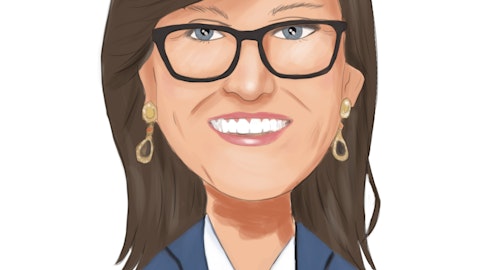I’m not sure there certainly will be KPIs. They may be things that we report on, but don’t guide to, we sort of need to, I think we got a feel for the types of deals that we’re going to be signing under the newer sort of commercial terms, Jason, outlined today, and you’re offering by clasps service.
Matt Sykes: Yes. Thank you.
Jason Kelly: As reminder, the way we do program counts today involve having things like downstream value share involved and order for its account, I guess a number of the out on the call do factor that into their modeling. And so part of what we’re doing here is because we’re changing the terms that they wouldn’t count. And so we do want to give you all a picture of how things are going because when we sign deals that does imply revenue in the future. I do know that’s part of the modeling. So we’ll work on that.
Matt Sykes: Got it. Thank you very much for that. And then just on the guidance commentary slide. Jason, you mentioned we’re prioritizing quality of — quantity in terms of programs. With sort of the new approach and including large area as a service, are there certain types of programs or end markets that are more attractive to achieve sort of combination of flexibility and scale, but also speed to get that program up and running? And/or are there certain — I think you mentioned the difference between those that are attracted at downstream value and those that are not, which is clear, but just sort of the types of customers that would maybe generate that revenue quicker in terms of either scaling on the platform or just in order to bring new programs to the platform.
Mark Dmytruk: Yes. Great question. So, I think for starters, you will continue to see us. I showed that slide where we’re either selling to the research budget directly. That’s the kind of lab data as a service type model, where their scientists is in control of our infrastructure or our scientists is running a program and we’re kind of doing a strategic deal with Quotta [ph]. And I say Quotta because they essentially are the ones who negotiate research partnerships upstream and down – I acquired an asset, and I also signed a research partnership with a small biotech, right, on the large biopharma Quotta leader like that we’re like half of that deal that’s like the research partnership has, right? That’s what we’re selling to.
We sell the pipeline of those. We’ll still do those. And I think frequently, those will still involve downstream value share. They’re going to be like a whole bunch all at once and really the customer for those is large biopharma, okay, and to a lesser degree, maybe large ag companies, all right. The research budget on the other hand, I think we have a really good opportunity with smaller biopharma start-ups and biotechs that are still getting funded and are making choices and limiting capital environment about how much they want to spend on their laboratory infrastructure. How much do they want to spend building that stuff out. How much they want to spend on equipment. All that upfront costs I think with their size, but they are uncompromising on.
This is what I – again, these are things you realize over time, we’re fundamentally selling a new thing. Those small biopharma biotechs would never give of scientific control. And so with our lab data as a service, where now their scientists can run our infrastructure, we can sell to those guys for the first time. So I’m really excited about that – about that area, in particular, when it comes to lab data as a service. Last one I’ll mention, our industrial biotechnology. We’ve done a hard time selling into the bigger companies there, okay, because they don’t really do those types of research partnerships department does. Now it’s a lower margin industry, but they do have research, but have research team. So I think lab data as a service is also a way that is an entree into some of those larger chemical and our industrial batter companies where we’ve had more friction selling on the strategic deals.
Does that make sense?
Matt Sykes: Yes. Thank you very much. Appreciate it.
Jason Kelly: And in general, like I like it. Like I think it gives us more — like these also reinforce each other. I think one of the things people are always like, I don’t talk of a CRO or something, which is a close to what the lab data as a service is. And that’s because when we’re talking to the strategic half of the house, they are like, I wouldn’t do a strategic deal with a CRO, right. And so there’s sort of a — when we’re talking to those folks, they are evaluating our scientists, they’re evaluating, whether we can do a multiyear deal. And we’re really great at that, and we’re good to engage with the people, people already think of us that way, right. They think about the strategic. So what I am excited about, though, is we can now walk into same customer, different part of the organization.
And our reputation over here is going to help us over here. So I am excited to cross-sell to both kind of directly to the R&D, mid-level and senior leadership as well as more strategic
Matt Sykes: Thank you.
Operator: Thanks, Matt. Next up, we have Mike Ryskin at Bank of America. Mike your line is now open.
Mike Ryskin: Hi, great. Thanks, guys. Can you hear me?
Jason Kelly: Yes. Hey, Mike.
Mike Ryskin: So I kind of want to go back to, I think, kind of the crux of your argument earlier, Jason. Just kind of looking at Slide 14, I think like settle perfectly the disconnect between active programs or new programs and revenues or why that disconnect every time. I’m just wondering, within that, we only see the total number, right, total programs, total revenues any success stories you can talk about? Any examples, any lessens you can give as you parse that out, whether you see some of the proof points because you’re talking a little bit about how it’s about not being able to get up to full scale cases where you are able to achieve that? And what I’m getting at is it’s a long question. But what I’m getting at is you’re putting in these cost cuts, you’re trimming things.
How do we know that’s not just going to trim the number of programs, trim the number of revenues and just cutting everything in half, right, by reducing headcount, reducing footprint, right? How do you know you’re selecting the better approach versus signing what you have now and cutting it in half?
Jason Kelly: Yeah. Super Mike. Yeah. So I’ll give a little color. So first off, we have now multiple years of experience with many programs, right? And again, you can see the ramp of our program. I know people that have followed us since listing the company know this. And so each year, we get more and more data about what’s easy to onboard and get to scale, what’s hard, right. Secondly, we are working on the back-end. We’re always trying to make the back end actually do this more quickly, right? And we have a substantial amount of bookings, right? Like this is the thing that frustrates me, right, like we actually have a lot of bookings and the rate at which we’re able to push them through the infrastructure into revenue is just too low, right?
And so I do — we need to work on that back-end problem. I think when it comes to what we know as success cases, it is the types of programs that we have done previously, right? Like if we have done that type of work, particularly if we’ve done that type of work end-to-end and succeeded for a customer, it is much easier for us to do it again. When it’s a newer thing that creates a lot more churn, right? And then I would say across the board, there’s still like a set of experiments like, for example, assay onboarding, right, The customer comes to us, they have their specific project as part of it, there’s a particular assay that they trust that they really want us to onboard onto the automation in order to make that project work. That remains something that like you can’t hand off to automation, like we have to do that pretty manually is pre-looking but I am looking above that and until you complete that, I can’t turn up the dial and generate all that revenue from running that assay thousands and thousands of times.
Does that make sense? And so like assay onboarding would be a great thing for us to be able to do with the rest. They are able to onboard quickly some of these things that are currently repeatedly frictional by hand work to get the automation spun up. We know what those things are because we’re doing so many programs. And those are some of the first things we’re going to attack with our new focus. So that really is it. And that’s why we’re confident that we aren’t going to have the situation you’re talking about. But again, what we sell will be different. Like I won’t be going out and saying, “Hey, I want to do a project for the first time, not in this world, right? Now when I see a line of sight to us getting to breakeven, we just don’t need to do that anymore.
And that — we’ve had to do — I think it was part of building the process here to start building the story. And how we learn has been easy and hard over the last few years. It is a mistake to keep selling that type of stuff. And so you’ll see us tighten up the sales there, but I’m hopeful with the better terms. We get more deals of the type you like. Does that make sense?
Mike Ryskin: Okay. No, that does. I appreciate that. And then just a quick follow-up on the cost reductions and the plan there, a pretty meaningful reduction in lab 25%, is that — how do you ensure sort of minimal disruption on scaling up for a while, you are still bringing on the new – the new foundry operations about that one. So how do you juggle both expansion and shift and meaningful headcount at the same time?
Jason Kelly: Yeah. I think that point is the key challenge for us, right? He is figuring out what are the things that we need to be investing in to make sure we can handle the shift and then also make sure we’re supporting our key customers today right? And so that is like a big part of what we worked on in early planning for this and what we’re going to be working on in the coming weeks with the team to tighten that up. We also do, I will say, post listings. We pursued many different ways to potentially get to growth. We do a lot of internal research to try to get something that’s going to pay off in the longer term. Some of that we did need to do two or three years ago, like we were very early now four years ago and even doing Mammalian Cells.
Of course, we needed to do internal research to bring that online we would never be able to tap the pharma industry today like we do. The list of things like that versus the payoff in this environment is just shorter. And so a lot of that internal research business work we should be doing, and we should be focusing that on either delivering on customer projects or making it easier to onboard things onto the automation, on to the pooled screening and things like that? Like you’re going to just see us focus a little more on just the stuff that delivers revenue and allows us to sell to the types of customers we want to sell to at a faster scale. Does that make sense?
Mike Ryskin: Yes. Okay. That’s helpful. Thanks guys.
Operator: Thanks, Mike. [Operator Instructions] Next up, we have Steve Mah at TD Cowen. Steve, your line is now open.
Jason Kelly : Steve, get you from SynBioBeta.
Steve Mah: Yes. So yes, apologies for the background noise, yes, to a great day. But anyway, maybe just a follow-up on Mike’s question on the risk and reduction in labor cost. I appreciate on the services business, you have good visibility on what’s easy and that you’ll take it on as a services project. But what about one-third of your programs during the harder pharma partnerships. Those are obviously more complicated. Can you give us a sense — is there a reduction in force? Is it more targeted — and then maybe give us — maybe quantitative the percentage of natural port reviews? And I know you said 25% of labor, but can you give us a sense of like what percentage of your total workforce is?





